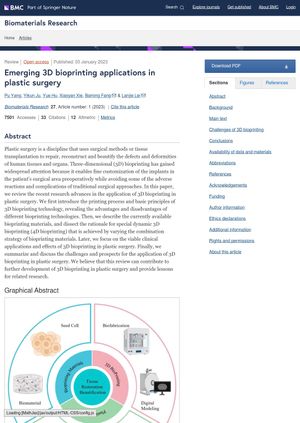Emerging 3D Bioprinting Applications in Plastic Surgery
January 2023
in “
Biomaterials Research
”

TLDR 3D bioprinting in plastic surgery could lead to personalized grafts and fewer complications.
The document reviews the application of 3D and 4D bioprinting in plastic surgery, highlighting its potential to reduce complications associated with traditional surgical methods. The technology allows for the design of individualized grafts, reducing the risk and duration of surgery. It discusses various bioprinting technologies, including inkjet-based, laser-based, and extrusion-based bioprinting, as well as novel technologies like acoustic and magnetic bioprinting. The document also explores the use of different materials in bioprinting, such as silk, Chitosan, and decellularized extracellular matrix. It introduces the concept of smart printing materials that can change their shape in response to various stimuli. The document discusses the potential of 4D bioprinting in areas like skin regeneration, ear reconstruction, and hair follicle regeneration, but notes the lack of reliable animal studies for hair follicle regeneration. It also highlights the use of 3D bioprinting in ear cartilage printing, rhinoplasty, breast implants, and maxillofacial bone restoration. Despite the advancements, the document notes challenges such as the need for accuracy, high costs, and operator skill, as well as ethical considerations.





